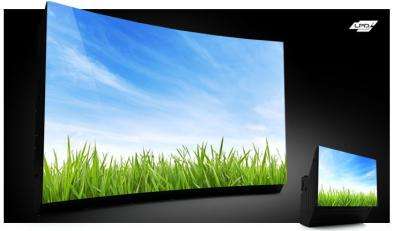(PhysOrg.com) -- Californian company Prysm has unveiled a high definition television with a "laser phosphor display" based on their patented method of using lasers reflected off a bank of mirrors to excite pixels on the television screen in a similar way to cathode ray tubes.
The laser phosphor display (LPD), called the TD1, was unveiled at InfoComm earlier this month. The first generation version consists of a rectangular glass screen 63 centimeters on the diagonal. Tiny patterns of phosphors are layered on the inside surface of the glass (or polymer), and these emit red, green or blue light when excited by a soft UV laser, to produce brilliant, high quality images. Since the phosphors are extremely close to the surface no image filtering is needed. The display can also be modified to suit specific viewing needs by using special coatings or substrates.
The solid-state laser diodes (similar to those in Blu-ray players) are mounted behind the screen and point up at bank of tiny, rapidly moving mirrors, rather like those used in laser printers. The mirrors reflect the laser light across the screen to produce the necessary number of image lines and create the picture. The resultant images have no motion blur or flicker.
The processor managing the laser varies the light intensity and turns the laser on and off, which means that when the display is dark the lasers are turned off to further reduce power consumption and increase the lifespan of the display.
The design results in a display that is currently 36 centimeters thick, but which has a greatly reduced power consumption a quarter that of LCDs and only one tenth of plasma televisions. The sets can be built with existing technology and there is no requirement for clean rooms in the manufacture of the screens, which cuts the expense considerably.
The TD1 does not suffer the problem of low brightness, which is suffered by rear projection sets. It also has the advantage that the displays are highly configurable and can be stacked seamlessly to create supersized high-resolution video walls of almost any size or shape. According to Prysm, the brightness and color range achieved exceeds LCD or LED technologies, and the viewing angle is almost 180˚. The fast response time of 240 Hz and the 1.6 mm dot pitch also both exceed competing technologies such as LED.
Prysm’s vice president of panel development and manufacturing, Patrick Tan, pointed out the fact that its technology has almost no requirement for new components gives the company a great advantage. All components, including the phosphors, mirrors and lasers are widely available, which makes development time short and reduces the time before production can be ramped up.
Prysm says it is dedicated to what it calls “ecovative” technology that is eco-friendly throughout its manufacture. As well as greatly reduced power consumption, the TD1 does not contain toxic components, has no consumables, and generates little heat.
Prysm says its HDTV television will be competitive with LCD and plasma televisions within three to five years.
More information: www.prysm.com/
© 2010 PhysOrg.com






















